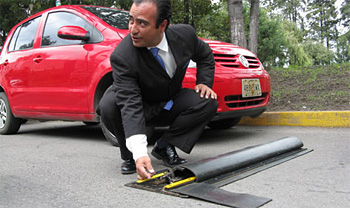
|  |  |  Technology News | October 2009 Technology News | October 2009  
'Smart' Speed Bumps Being Developed in Mexico
 Chris Hawley - USA Today Chris Hawley - USA Today
go to original
October 06, 2009


| | Carlos Cano, president of Mexico's Decano Industries, shows the speed bump prototype. (Sergio Solache/USA Today) |  |
Toluca, Mexico — Speed bumps are so common here that residents sometimes decorate them for the holidays, painting "Happy New Year" or "Happy Independence Day." One rock band, The Sam-Sam, even has dedicated a song to them.

Yet concerns over the environment — and the utter annoyance of having to brake and accelerate frequently — have prompted one Mexican state government to embrace a "smart" speed bump that could make driving smoother, without sacrificing safety.

The device, being developed by Mexico-based Decano Industries, automatically lowers into the ground when drivers go the speed limit or slower. Drive too fast, and the bump stays up.

"With this speed bump, people will feel rewarded for obeying the law," says Carlos Cano, the company's president.

The technology is relatively basic: The speed bump is formed by two steel plates that form a triangle sticking out of the pavement. When a car tire touches the plate, a patented device under the triangle measures the force of the impact.

If the tire's impact is gentle enough — that is, if the vehicle is traveling slowly — both plates immediately collapse into the ground under the weight of the car.

The device is still in the prototype stage, Cano says.

The government of Mexico state, the populous state that surrounds Mexico City on three sides, sees enough promise in it that it is providing grant money and legal help to get the invention patented in Mexico and abroad.

Olivia González, chief of projects for the Mexico State Council for Science and Technology, says the device should help improve the environment in an area with notoriously dirty air.

A study by Mexico City Autonomous University in 2006 found that cars traveling over speed bumps used significantly more fuel and emitted more pollutants.

Speed bumps are especially popular in Mexico because few police officers are able or willing to enforce traffic laws, says José Luis Camba, a civil engineer and professor at the National Autonomous University of Mexico. There are at least 18,000 speed bumps in central Mexico City alone, according to the government.

Few police officers have radar guns, and speeders who are caught usually get off with a warning by paying a bribe of a few dollars, Camba says.

"So the government takes the easy way out and builds a speed bump," Camba says. "Or sometimes neighbors just get so frustrated that they build one themselves. It's a symptom of a lack of respect for the law."

Car ownership in Mexico has more than doubled in the past decade, to 26.5 million registered vehicles in 2007, according to the government.

Inventors in other countries are working on similar devices, but Decano says its speed bump is tailored for a developing country.

It requires no electricity, costs about $1,500 per lane and will last about 10 years with annual $50 maintenance, Cano says.

The mechanical version can be set for speeds up to 25 mph, but the company also has an electric prototype that can be used in faster speed zones.

Some drivers have doubts.

"I think they'll get stolen, or they'll break because the government doesn't maintain anything," says Marielena Ramírez, 27. "They should just get rid of speed bumps, not try to make them smarter."

Hawley is Latin America correspondent for USA Today and The Arizona Republic
|

 |
|  |



